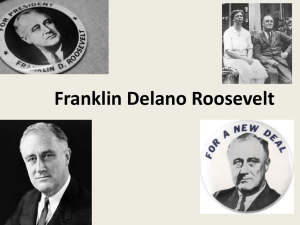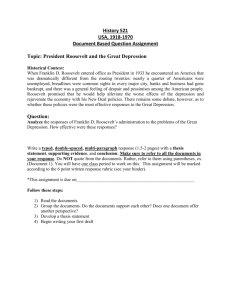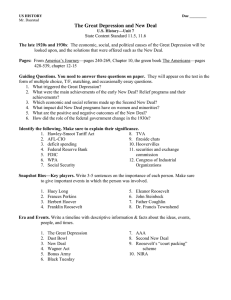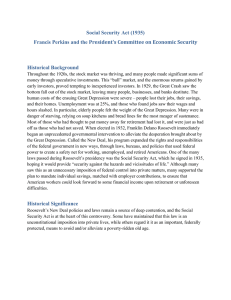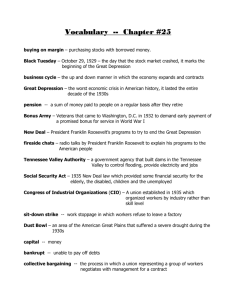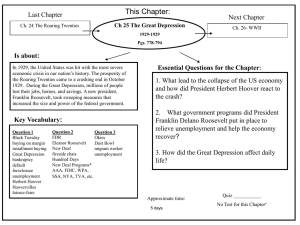Document 17551751
advertisement
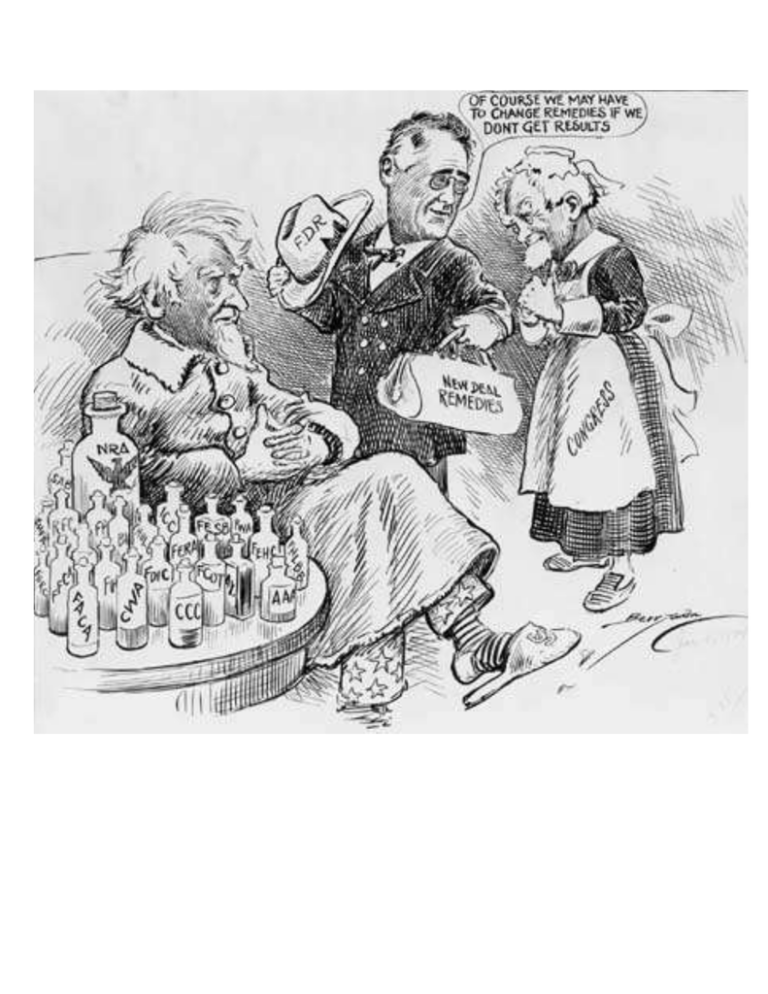
The Great Depression in the United States began on October 29, 1929, when the American stock market crashed. Speculators lost their shirts; banks failed; the nation’s money supply diminished; and companies went bankrupt and began to fire their workers. Meanwhile, President Herbert Hoover urged patience and self-reliance: He thought the crisis was just “a passing incident in our national lives” that it wasn’t the federal government’s job to try and resolve. When President Franklin Roosevelt took office in 1933, he acted swiftly to provide jobs and relief to those who were suffering. Over the next eight years, the government instituted projects and programs, known as the New Deal. GREAT DEPRESSION LEADS TO A NEW DEAL FOR THE AMERICAN PEOPLE On March 4, 1933, at the height of the Great Depression, Franklin Roosevelt said, “let me assert my firm belief that the only thing we have to fear is fear itself.” The next day, the new president declared a four-day bank holiday to stop people from withdrawing their money from shaky banks. In his first “fireside chat” three days later, the president urged Americans to put their savings back in the banks, and by the end of the month almost three quarters of them had reopened. THE FIRST HUNDRED DAYS Roosevelt’s quest to end the Great Depression was just beginning. Next, he asked Congress to take the first step toward ending Prohibition by making it legal once again for Americans to buy beer. (At the end of the year, Congress ratified the 21st Amendment and ended Prohibition for good.) In May, he signed the Tennessee Valley Authority Act into law, enabling the federal government to build dams along the Tennessee River that controlled flooding and generated inexpensive hydroelectric power for the people in the region. That same month, Congress passed a bill that paid farmers (farmers who produced things like wheat, dairy products, tobacco and corn) to NOT plant crops in order to end agricultural surpluses and boost prices. It also suspended some antitrust laws and established a federally funded Public Works Administration. THE SECOND NEW DEAL Despite the best efforts of President Roosevelt and his cabinet, however, the Great Depression continued–the nation’s economy continued to wheeze; unemployment persisted; and people grew angrier and more desperate. So, in the spring of 1935, Roosevelt launched a second, more aggressive series of federal programs, sometimes called the Second New Deal. In April, he created the Works Progress Administration (WPA) to provide jobs for unemployed people. WPA projects weren’t allowed to compete with private industry, so they focused on building things like post offices, bridges, schools, highways and parks. The WPA also gave work to artists, writers, theater directors and musicians. In July 1935, the National Labor Relations Act, also known as the Wagner Act, created the National Labor Relations Board to supervise union elections and prevent businesses from treating their workers unfairly. In August, FDR signed the Social Security Act of 1935, which guaranteed pensions to millions of Americans, set up a system of unemployment insurance and stipulated that the federal government would help care for dependent children and the disabled. THE END OF THE NEW DEAL? Meanwhile, the New Deal itself confronted one political setback after another. People against the New Deal said it was an unconstitutional extension of federal authority. In order to protect his programs from further meddling, in 1937 President Roosevelt announced a plan to add enough liberal justices to the Court to neutralize the conservatives. This “Court-packing” turned out to be unnecessary–soon after they caught wind of the plan, the conservative justices started voting to uphold New Deal projects– but the episode did a good deal of public-relations damage to the administration and gave ammunition to many of the president’s Congressional opponents. On December 7, 1941, the Japanese bombed Pearl Harbor and the United States entered World War II. The war effort stimulated American industry and, as a result, effectively ended the Great Depression. THE GREAT DEPRESSION AND AMERICAN POLITICS From 1933 until 1941, President Roosevelt’s programs and policies did more than just adjust interest rates, tinker with farm subsidies and create short-term make-work programs. They created a brand-new, if tenuous, political coalition that included white working people, African Americans and left-wing intellectuals. These people rarely shared the same interests–at least, they rarely thought they did–but they did share a powerful belief that an interventionist government was good for their families, the economy and the nation. Their coalition has splintered over time, but many of the New Deal programs that bound them together–Social Security, unemployment insurance and federal agricultural subsidies, for instance–are still with us today.
